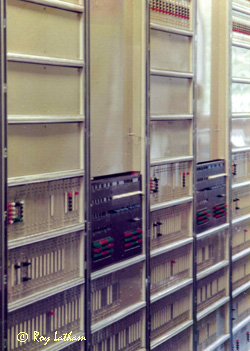 |
Belgravia Telephone Exchange was the test site for SPC 1C - the replacement for directors and local registers - before MOST. In 1966 there was one rack which replaced the SHTE (Short Holding Time Equipment) equipment for most of the day. In 1976 it was extended to five racks and the directors were completely removed. |
Roy Latham worked in Belgravia and Pimlico exchanges in the 1970s and he recalls some of his memories...
Belgravia 01-235
The building itself was very unusual; it was opened in 1960 and the roof had a scalloped effect over each of the large windows on the fourth floor. It also featured a balcony on the front and rear as well as huge, square windows in metal frames which could be opened to the horizontal. It was built out of reinforced concrete, and to put it very simply, stuck out like a sore thumb! At the time of writing (2003) the building was still in service with only a few alterations (unlike so many others - Millbank and Cunningham have been sold and are being converted to flats!).
Belgravia Telephone Exchange was the test site for SPC 1C - the replacement for directors and local registers - before MOST. In 1966 there was one rack which replaced the SHTE (Short Holding Time Equipment) equipment for most of the day. In 1976 it was extended to five racks and the directors were completely removed.
In between Millbank (01-821) was opened as a overflow unit for Pimlico and that was the first truly directorless exchange. During that era, Pimlico was home to the London Radiophone Service (forerunner of the cellular phone) and also housed the radiopaging equipment for London Radiopaging.
The London Radiophone Service
The London Radiophone Service opened on 5th July 1965. The aerials for this were located at three sites, Kelvedon Hatch, Pimlico and Beulah Hill.
Tate Gallery Exchange housed the manual board for its operation.
Southbank 01-928
Was the biggest TXE4 unit ever installed with 28 switching units. However, it was manufactured with half a million bad transistors! GPT had just finished replacing all of them when the equipment floor was flooded! By the time the exchange was commissioned, the cards had been pulled so many times that the exchange had reached the end of its working life! It did see service, but was replaced by a TXD fairly soon afterwards.
The problem with the TXE4 cards (and most other electronic cards) is that they have gold-plated contacts on the edge connectors. As gold is very soft it wears away after a certain number of card insertions and removals. With Southbank the cards were pulled so many times whilst rectifying the myriad of problems the gold wore down to almost nothing!
Of his background Roy enthuses:
My father was in 10 Downing Street and the Foreign Office as an installer, and later a test clerk at Whitehall, and my mother was a PBX control supervisor who worked for a time on the switchboard at MI5. As you see, I come from a GPO family!
Register Equipment
Type 12-A Stored Program Control Director (SPC) produced in the late Sixties which used ferrite cores, transistors and diodes.
Type 13-The Metal-Oxide-Semiconductor-Transistor (MOST) Director was produced in 1979.
References
POEEJ July 1966 Incoming Core-Type Register-Translator for Director Areas by C.K. Price and W.A. Ireland.
POTJ Autumn 1965 Telephones on Wheels by J.L. Hyatt.
Page last updated June 2015 revision. Checked May 2021.
All logos and trade marks are the property of their respective owners and are used on the Light Straw site(s) for review only. Students and researchers are recommended to make their own independent enquiries as to the accuracy of the information contained therein.